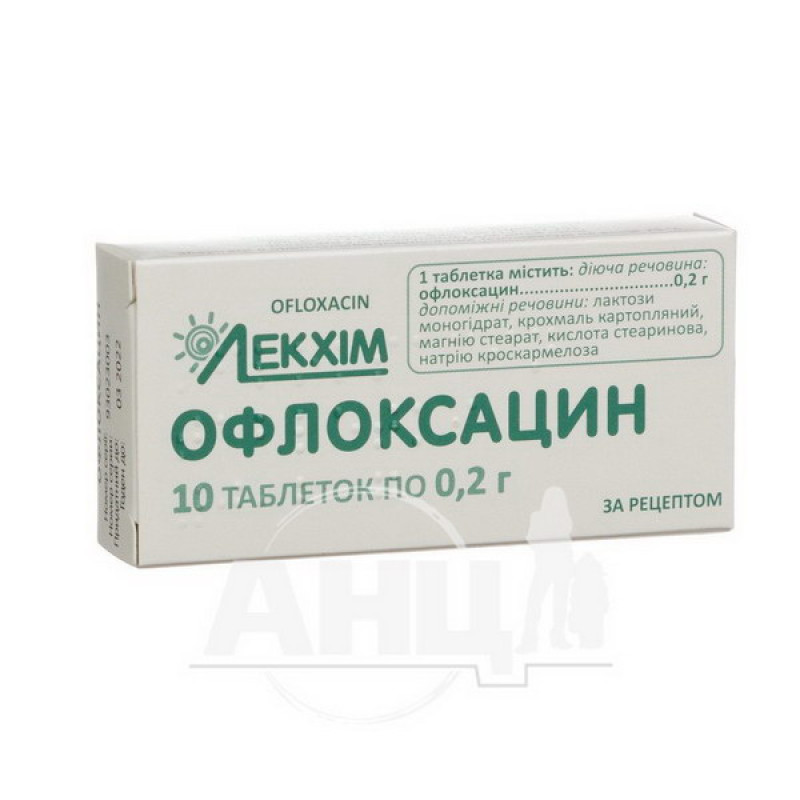Ofloxacin tablets 0.2 g blister No. 10

Ofloxacin tablets are used for infectious and inflammatory diseases caused by pathogens sensitive to ofloxacin:
exacerbation of chronic obstructive pulmonary disease (including chronic bronchitis), community-acquired pneumonia; uncomplicated acute cystitis, urethritis, acute pyelonephritis and complicated urinary tract infections; complicated skin and soft tissue infections; gonococcal urethritis and cervicitis caused by susceptible strains of Neisseria.Composition
Active ingredient: ofloxacin;
1 tablet contains 0.2 g of ofloxacin;
Excipients: lactose monohydrate, potato starch, magnesium stearate, stearic acid, croscarmellose sodium.
Contraindication
hypersensitivity to the active substance, to other components of the drug or to other fluoroquinolones; epilepsy, central nervous system damage with a reduced seizure threshold (after craniocerebral trauma, stroke, inflammatory processes of the brain and meninges); history of tendinitis; glucose-6-phosphate dehydrogenase deficiency; the drug should not be used in patients with prolonged QT interval, uncompensated hypoglycemia, as well as in patients who are simultaneously taking drugs with the ability to prolong the QT interval (class IA and III antiarrhythmic drugs, tricyclic antidepressants, macrolides, antipsychotics).Method of application
The drug is administered orally. The tablets should be swallowed with liquid. The interval between the use of ofloxacin and the use of sucralfate, zinc or iron preparations, antacids containing aluminum / magnesium, should be at least 2 hours, since the absorption of ofloxacin may decrease when taken simultaneously with these drugs.
Application features
Pregnant women
Ofloxacin is contraindicated during pregnancy.
Children
The drug is contraindicated in children.
Drivers
During treatment with ofloxacin, you should refrain from activities that require increased attention and quick reactions (e.g., driving vehicles).
Overdose
Symptoms: The most important expected signs of acute overdose are central nervous system symptoms, including confusion, dizziness, impaired consciousness and seizures, as well as gastrointestinal reactions such as nausea and erosive lesions of the mucous membranes.
Treatment: In case of overdose, it is recommended to take appropriate measures to remove unabsorbed ofloxacin, for example, gastric lavage, administration of adsorbents and sodium sulfate, if possible within the first 30 minutes after overdose. Antacids are recommended to protect the gastric mucosa.
The elimination of ofloxacin can be enhanced by forced diuresis.
Side effects
From the organs of vision: irritation of the mucous membrane of the eyes, conjunctivitis, nystagmus, decreased visual acuity, visual disturbances (including diplopia, photophobia), color blindness. From the organs of hearing and vestibular apparatus: dizziness, tinnitus, decreased hearing acuity, hearing loss, impaired coordination of movements. From the respiratory system, chest and mediastinum: cough, nasopharyngitis, shortness of breath, bronchospasm, allergic pneumonitis, rhinorrhea, wheezing, allergic pneumonitis, feeling of lack of air, respiratory arrest, dyspnea, severe asphyxia. Gastrointestinal: anorexia, abdominal pain, nausea, vomiting, diarrhea, enterocolitis (sometimes hemorrhagic), pseudomembranous colitis, dryness or burning in the mouth, dyspepsia, heartburn, flatulence, constipation, intestinal colic, intestinal perforation, intestinal bleeding. Liver and biliary tract: increased levels of liver enzymes and bilirubin in the blood plasma, jaundice (including cholestatic, parenchymatous), hepatitis, necrosis. Kidneys and urinary system: increased levels of creatinine in the blood plasma, acute renal failure, interstitial nephritis, polyuria, dysuria, anuria, frequent urination, urinary retention, hematuria, albuminuria, candiduria, formation of kidney stones. Metabolism: hyperglycemia, hypoglycemia in patients with diabetes mellitus taking hypoglycemic drugs, increased levels of triglycerides, cholesterol and potassium in blood plasma, acidosis. Nervous system: headache, drowsiness, paresthesia, dysgeusia, parosmia, peripheral sensory neuropathy, peripheral sensorimotor neuropathy, convulsions, exacerbation of myasthenia gravis, extrapyramidal disorders or other disorders of muscle coordination, memory impairment, development of epileptic seizures, ataxia, tremor, decreased reaction speed, increased intracranial pressure, vertigo. Psychiatric: agitation, sleep disorders, insomnia, mental disorders (including hallucinations, paranoia, manic thoughts), anxiety, confusion, nightmares, depression, psychotic disorders and depression with self-destructive behavior, including suicidal thoughts or suicide attempts; euphoria, phobias, irritability, anxiety, spatial disorientation. Cardiovascular: tachycardia, hypotension, ventricular arrhythmias, polymorphic ventricular tachycardia of the "pirouette" type (the occurrence of these reactions was observed mainly in patients with risk factors for prolongation of the QT interval); prolongation of the QT interval on the ECG, hypertension, cerebral thrombosis, cardiac arrest, shock. Blood and lymphatic system disorders: anemia, hemolytic anemia, leukopenia, neutropenia, eosinophilia, thrombocytopenia, agranulocytosis, bone marrow suppression (which disappears after discontinuation of the drug), pancytopenia. Development of pinpoint hemorrhages (petechiae), hematomas and nosebleeds. Immune system disorders: hypersensitivity reactions, including anaphylactic/anaphylactoid reactions, angioedema, anaphylactic/anaphylactoid shock. Skin and subcutaneous tissue disorders: rash (including pustular, hemorrhagic), itching, urticaria, flushing, hyperhidrosis, erythema, Lyell's syndrome, photosensitivity, drug dermatitis, vascular purpura, vasculitis, which in exceptional cases can lead to skin necrosis, Stevens-Johnson syndrome, generalized exanthematous pustulosis, drug eruptions, exfoliative dermatitis, skin hyperpigmentation, nail discoloration or delamination. Musculoskeletal and connective tissue disorders: tendinitis, arthralgia, myalgia, tendon ruptures (including Achilles tendon), which may be bilateral and occur within 48 hours of starting treatment, rhabdomyolysis and/or myopathy, muscular weakness, muscle cramps, muscle tears, muscle ruptures, tendon pain. Reproductive system and breast disorders: irritation, burning and painful rashes on the external genitalia in women, vaginitis, dysmenorrhea, hypermenorrhea, metrorrhagia. Congenital and familial/genetic disorders: acute attacks of porphyria in patients with porphyria. Infectious and parasitic diseases: superinfection, development of secondary infection (including mycoses), development of resistance of pathogenic microorganisms.Interaction
When using the drug simultaneously with other drugs, the following interactions are possible:
with antacids containing aluminum/magnesium, sucralfate, zinc, iron preparations - reduced absorption of ofloxacin; it should be taken 2 hours before taking these drugs; with drugs that are excreted by tubular secretion (e.g. probenecid, cimetidine, furosemide, methotrexate) - impaired excretion and increased plasma levels of ofloxacin; with drugs with the ability to prolong the QT interval (e.g. antiarrhythmic drugs of classes IA and III, tricyclic antidepressants, macrolides, antipsychotics) - additional prolongation of the QT interval; simultaneous use of drugs is contraindicated.Storage conditions
Keep out of reach of children.
Store in the original packaging at a temperature not exceeding 25 °C.
Shelf life - 3 years.
There are no reviews for this product.
There are no reviews for this product, be the first to leave your review.
No questions about this product, be the first and ask your question.







